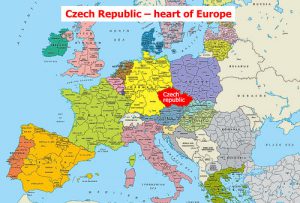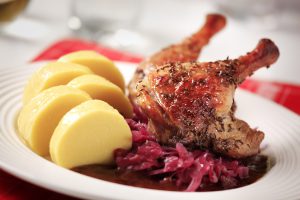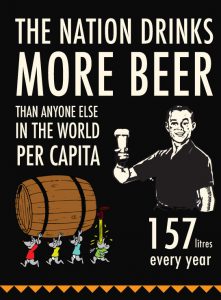Food, drinks, religion, location… What should you know before entering into our amazing Czech community? Here you can learn some basics about this – here important – Central (not Eastern!) European country.
Eastern Europe? Not anymore…

For some European countries, especially those from the West Europe, Czech Republic is still considered Eastern European country, which evokes poverty and weirdness. It is of course an outdated opinion and it’s easy to prove that. Czech Republic is a member of EU (including the Schengen), UN, and NATO, and – what’s maybe more important – is richer than some western European countries! So, have in your mind that before you’ll use the term “eastern Europe” to describe location of Czech Republic, take into account that people here much more prefer the term “central Europe” 🙂
Religion
Even though Christianity has a strong tradition in the Czech culture, because people celebrate Christmas and Easter, it is not a country of strong believers. Only around 10% of the people are practicing Christians, the rest either does not attend church, does not believe in the existence of God or believes in some kind of undefined spirit or life force. The reasons originate in the 19th century when the country was facing germanization tendencies and the society was being formed on liberal tendencies in opposition to the Roman-Catholic church. Also during the communistic era, all churches were controlled by the state and the members were being persecuded, leading to today’s state of things. Other religions are not very common and may appear surprising to Czechs. Even though the total number of evangelicals and charismatics is small, some of these denominations have multiplied their membership several times in the 10 years between the last two censuses.
The apparent lack of interest in traditional forms of Christianity is accompanied by the massive popularity of what sociologists call “invisible” or “alternative” religion and what could be best described as a belief in magic. Czechs may not be very enthusiastic churchgoers but many of them easily accept the idea that fortune-tellers can predict the future, lucky charms bring good fortune or that the stars might influence their lives.
LGBT Community

Czech Republic is a very liberal and tolerant country, probably because of the low level of religiousness. What’s more – registered partnership is legal, however adoption by the same-sex couple is not possible. Czechs are tolerant even in the army which does not question the sexual orientation of soldiers. People are also generally tolerant to public displays of affection as long as it is within boundaries of common decency. Once a year in the middle of August there’s a celebration of Czech tolerance with Prague Pride – the biggest LGBT festival in central Europe.
Czech food

Everyone who already tried – knows about that – the traditional Czech cuisine is not the healthiest one. It is even sometimes perceived as heavy for some nations. But this has an explanation – people needed a lot of fat to stay warm and to have a lot of energy especially during the cold winters. Breakfast would usually consist of some kind of pastry, e.g. a pie, a slice of bread or with ham or cheese. Lunch is the main meal of the day and it traditionally comes with a soup first, for instance potato soup, garlic soup, chicken soup… and is followed by the main course. It is served at around noon until 2 p.m. Many restaurants have “lunch menu” with reduced price on a selected meal. Usually there is a choice between two or three of them and soup is either included or can be bought separately. Such lunch costs around 100 CZK including one drink, but of course depends on the type of the restaurant.
Desserts are not traditionally served, but restaurants offer a variety of them, e.g. traditional honey cake or apple strudel. Dinner is usually lighter than lunch and it is not an exception when the dinner served at home is cold. Meals worth trying when being here are Schnitzel, goulash, beef sirloin cream sauce with dumplings and cranberries, fruit filled dumplings, halušky and of course fried cheese with French fries and tartar sauce!
Drinks

What is common here, people put milk in their coffee, but usually do not put milk in their tea. Also quite a lot of mineral water of Czech origin is drinking by Czech people. Alcohol can be bought at the age of 18 and cannot be consumed on the street, even though such behavior is often tolerated. The most popular among alcohols is – here no doubts – beer! It is a very important part of the Czech culture. Czechs drink the most beer per capita in the entire world. Despite this fact, there is zero tolerance for driving under influence of any alcohol. The most common type of beer to drink is pale lager and it comes in 0,5l (17 fl. oz.) glass with a foam on top. Drafting a perfect beer is a skill and there are different ways for different types of beer. When eating a heavier meal, you are supposed to have a beer, because it should help the digestion process. That is why some Czech people would rather give their child a small glass of non-alcoholic beer than a glass of Coca-Cola. It also costs less – 0,5l glass is usually around 25 – 40 CZK. So no matter how long you’re staying here – you have to try it at least once!
Interesting fact: Did you know that Budweiser comes from the Czech Republic, but it is not the same as the American one? In USA, it is sold under the name “Czechvar”!
But Czech Republic it’s not only a beer when it comes to alcohols. There is also a wine production, mainly in the south of Moravia. The most common varieties are Müller Thurgau and Saint Laurent but there are other well-known varieties such as Pinot Noir, Chardonnay or Sauvignon Blanc.

Is there a novel, book that we can read to give us a historical perspective of the Czech Republic?
Inquiry about a town in Czechoslovakia (circa 1880). I am researching my grandfather’s background. His Ellis Island documents claim he was born in 1880, in a town called Niznig Tvarosc, Czechoslovakia. I know my grandparents were estranged from one another following their arrival in New York and settling in first, New Haven, CT, USA and then moving a bit north to Meriden, CT, USA. Has the town name changed since the 1880’s? I have yet to identify it on Google Earth or another resource. Anything information you can share would be warmly appreciated.
With kind regards,
Paul D. Fellegy
Richmond, TX, USA
Found it, it’s in Slovakia:
https://en.wikipedia.org/wiki/Ni%C5%BEn%C3%BD_Tvaro%C5%BEec
V. R.